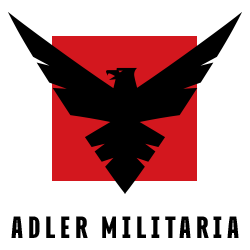Showing 550–558 of 1325 resultsSorted by latest
-
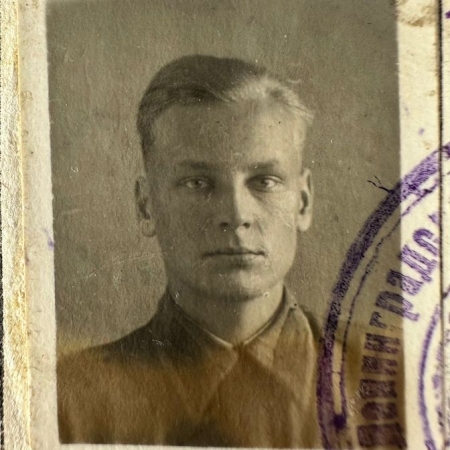
WWII Soviet Estonian – Political Commissar Medal & Photo Identification Papers Grouping – Special War Correspondent Lembit Remmelgas – Estonian NKVD – 8. Eesti Laskurkorpus – 249 Estonian Rifle Division – Siege of Leningrad – Battle of Narva 1944 – Politruk – Famous Estonian Post War
Untouched original grouping with NKVD Issued Documents. Remmelgas was a famous Estonian and has a large Wikipedia Page. It seems that post war he was a very celebrated Soviet Estonian writer, screenwriter, critic and winning a rare medal: Honoured Writer of the Estonian SSR in 1980. The War, he worked in front-line newspapers.From 1950 to 1953 he was editor of the literary and artistic newspaper Sirp ja Vasar (Hammer and Sickle). Since 1964, he served as editor-in-chief of the Tallinfilm film studio. Remmelgas spent his childhood and youth in Narva , where he graduated from high school in 1938. Immediately afterwards he began his journalistic work. After the Sovietization of Estonia in June 1940, he was editorial secretary in the newspaper Narva Tööline (‘Workers of Narvas’). He spent the Second World War in the Soviet Union , temporarily as a newspaper editor in besieged Leningrad . After the war he worked again in various newspaper editorial offices in Soviet Estonia . From 1949 to 1953 he was secretary of the Central Committee of the Estonian Komsomol . During this time he also completed a distance learning course at the Higher Party School in Moscow , which he completed in 1955. Remmelgas had been a member of the CPSU since 1943 and a member of the Estonian Writers’ Union since 1952 , in which he temporarily held various positions; from 1981 to 1983 he was its deputy chairman. The Grouping consists of the following original period items: 1. Red Army ID Booklet – (Soldbuch/Paybook) – Issued in 20.08.1942 with the Leningrad Front – Political NKO Department – With original Uniformed Photograph – Rank of red Army Soldier – Deployed with Special Redaction POLF (Political Newspaper) – He was born in 1921, he was from Yamburg, Petrograd Russia – Called up in 1941 to the Red Army – His profession was a Journalist – Units Served with: 1943/1944 – 249 Est Rifle Division – (8th Estonian Corps) – 8. Eesti Laskurkorpus – 1944 – Promoted to Non Commissioned Officer – Political Department of the 8th Army – Political Commissar. Awards: Defense of Leningrad Medal – 26.06.1944 – Armed with Revolver Nagant – He was demobilised in June 1944. Unit History: The corps fought a total 916 days in the war, and at different times it was in service on the Kalinin, the Leningrad and the 2nd Baltic Front. For 344 days, parts of the corps were engaged with German forces, but no significant gains were made. For the next 123 days, the formation was engaging in the Battle of Velikiye Luki where 13,000 of the 27,000 men were killed or wounded. Then, 37 days were spent in the Battle of Narva, and the final 88 days were devoted to the Battle of Courland. During the Battle of Narva in 1944, the artillery of the rifle corps fired on the 20th Waffen Grenadier Division of the SS (1st Estonian), consisting of Estonians fighting in the Waffen SS. The infantry of the corps was engaged in direct battle with the Estonians on the German side in the battles of Porkuni and Avinurme on 20 and 21 September 1944, where a detachment of the rifle corps murdered a number of wounded prisoners of war.[7] On 22 September elements of the 7th Rifle Division, along with the 45th Estonian Tank Regiment and the 952nd SU Regiment (SU-76s), formed the forward detachment of the corps and entered Tallinn, for which all three units received the name of that city as a battle honor.[8] 2. Pay Book for Officers of the Red Army – issued by 197 Separate Brigade – Paid 800 rubles from the 249 Rifle Div Estonian – Served as an Officer in the 249 Rifle Division Estonian for three months. 3. Red Army Officers Equipment Book – Issued in 1944 – Issued to a War Correspondent Lembit Remmelgas – Issued the following items: Cap, overcoat, tunic, trousers, shirt, long johns, towels, boots, wool blend sweater, warm shirt, warm long johns, winter gloves, foot wraps for bikes, flask with cover, cape, duffel bag, bowler hat, limit card for the 4th quarter of 1944 of the year. 4. Letter from the Bolshevik Party of Estonia – Stating that Remmelgas took part in a 3 month course (march till June of 1941) as a journalist organised by the department of the Communist Party of Estonia. 4. Letter from NKVD – SARK Narva – 11.07.1941 – 30.08.1941 – Temporary Identification Paper – Issued to Lembit Remmelgas – Permission to carry and use an American Made Rifle – Eesti NSV Siseasjade Rahvakomissariaat 5. Letter from NKVD – 16.07.1941 – Pass for Lembit Remmelgas – Correspondent for Newspaper called Narva Tööline (‘Workers of Narvas’)- as Vice Editor 6. Letter from Newspaper – Heros Storm – 11.10.1941 – Certificate – That he worked form 1 Sept – 10 October worked with the Newspaper – as Illustrator 7. Letter from Newspaper – Heros Storm – 11.10.1941 – Order from Department to Remmelgas – Signed by Battalion Commissar 8. Letter from Vice Chairman of the Estonian SSR – 3.01.1943 – States that Remmelgas is a Special War Correspondent with Rahva Hyal (Voice of the People) of the 8th Estonian Rifle Corps – Should be afforded all assistance in his duty as a Special Correspondent 9. Original Siege of Leningrad Medal – Original example 10. Post War Reserve Officer Card – 1961 – Orders to attend training Final Comments An exceptionally rare set of documents issued to a special war correspondent with the Estonian 8th Army Corps of the Red Army. He took part in the war as mainly working for Newspapers creating Soviet Propaganda to motive and inspire the troops. It seems post war he became quite famous in the Estonian SSR. Earning very high awards for his work, many articles online and books written by Remmelgas. Interestinglyy for a period he was also an Illustrator, I am sure its possible with further research to find out more about this man. For…
-
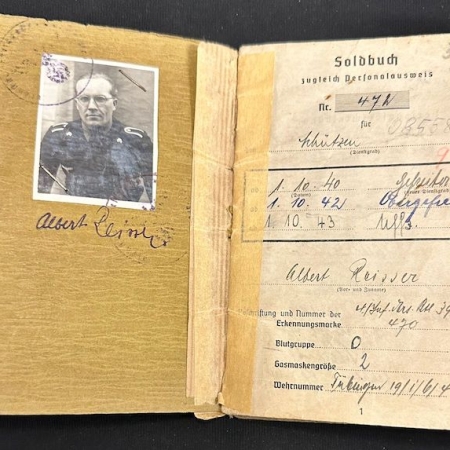
WWII German Wehrmacht Soldbuch – Uffz Reisser – Panzer Abteilung Norwegen – Narvik – Beutepanzerkompanie Stavanger – Panzer Wrap Picture! – rare (Offer Accepted)
$365.00Issued to the then soldier in 1939, Reisser was born in 1919 in Tübingen Germany. He served on the Eastern Front with Infanterie Regiment 435, and almost froze to death in December of 1941 in Russia. After his recovery, he was assigned to the Reseve Panzer Abteilung 7 and later to Panzer Abteilung Norwegen. According to his Equipment list it is like he commanded a tank. As he was issued Binoculars and a compass as well as a P38 Pistol. interestingly he also had a private pistol, a Mauser 7.65mm, he handed this ver when the German later capitulated as it is made note of. Awards; Eastern Front Medal and the Wounds Badge in Black. It was in Stavanger , in southern Norway , that in 1942 – 1943 , the German command created the Beutepanzerkompanie Stavanger (= armored capture company; that is to say, using vehicles captured from the enemy armies), mainly equipped with French Hotchkiss and Somua tanks . It was intended to replace, temporarily, the 25th Panzer Division , when the latter was sent to the Eastern Front in the summer of 1943 . Nearly everything I have seen on the market related to Norway is related not to Armoured Units.
-
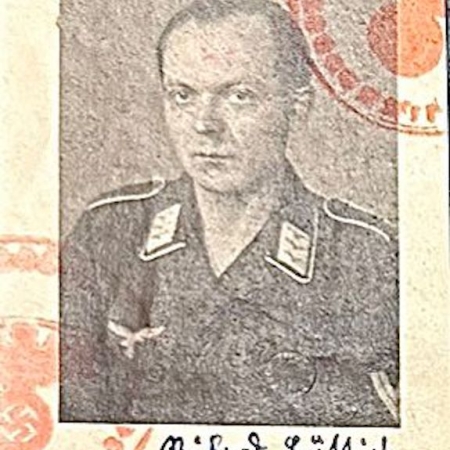
WWII German Luftwaffe Soldbuch – Obgefr Hüttich – Regiment General Göring – 1941 till 1945 – Fallschirm-Panzer-Division 1. Hermann Göring – Guard in Berlin! – Rare
Hüttich was a Berlier, living in Berlin Charlottenburg, he was. a show maker by proffesion before he was accepted into the Elite Wach Batl. They served as guards for Görings Facilities in Berlin, as well as air protection for Hitlers Bunker and Train in Berlin. He was there from 1941 and moved through the various branches during the war. Very desirable unit. Unit History The Fallschirm-Panzer-Division 1. Hermann Göring (1st Paratroop Panzer Division Hermann Göring – abbreviated Fallschirm-Panzer-Div 1 HG) was a German Luftwaffe armoured division. The HG saw action in North Africa, Sicily, Italy and on the Eastern front. The division was the creation of Reichsmarschall Hermann Göring and increased in size throughout the war from an Abteilung (battalion) to a Panzer corps. In 1935, Göring was promoted to command of the Luftwaffe. Unwilling to leave his favourite unit behind, he ordered it transferred to the Luftwaffe, renaming the unit Regiment General Göring in September 1935. The unit was now sent for re-training and re-equipping as a Luftwaffe unit. During this period, the I.Jäger-Bataillon and 15. Pionier-Kompanie were sent to Döberitz for parachute training. These units were separated from the regiment in March 1938 and redesignated I./ Fallschirmjäger-Regiment 1, the first of the Fallschirmjäger (airborne) units. By early 1936, the regiment was again ready for action. By this time, all organised resistance to the NSDAP had either been crushed or left Germany, and so the regiment was put to work as a personal bodyguard for Göring and providing flak protection for Hitler’s Headquarters. When Germany annexed Austria in the Anschluss of March 1938, the regiment was one of the first units to cross the border. Similarly, during the invasion of the Sudetenland in October 1938 and the occupation of Prague in March 1939, the General Göring was among the first units in the German occupation force. During the invasion of Poland, only a small part of the regiment was involved in the fighting. The majority of the unit was to stay in Berlin to continue their duties providing flak protection and guards for Göring and the NSDAP leadership. During the invasions of Denmark and Norway, elements of the regiment (a guard battalion, a motorcycle company and a flak component) took part in the campaign and acquitted themselves well. The main body of the regiment had been moved west to the German-Dutch border using the cover designations FlaK-Regiment 101 and FlaK-Regiment 103. During Fall Gelb, this force took part in the invasion of the Netherlands and Belgium. The imposing fortress of Eben Emael was captured and neutralised by Fallschirmjäger, many of whom had previously served in the General Göring. After the capitulation of the Netherlands, the regiment was broken up into several small Kampfgruppen and these were attached to the Panzer divisions spearheading the advance. The regiment again acquitted itself well, especially the flak troops, who often operated in an anti-armour capacity. In an engagement at Mormal Wood, heavy 8.8 cm FlaK 18s engaged French tanks at ranges of only a few yards. During this battle, the regiment gained a reputation for steadfastness under fire.[citation needed] After the surrender of France, the regiment was stationed on the Channel coast, before being moved back to Paris to provide flak protection for the city. Late in 1940, the regiment was moved back to Berlin to resume its former duties as honour guards and flak protection. Barbarossa – North Africa In early 1941, the regiment was reorganized as a motorized regiment. During this time, it was redesignated Regiment (mot) Hermann Göring, as Göring had been promoted to Reichsmarschall. After this restructuring, the regiment was moved east to take part in the invasion of the Soviet Union. When Benito Mussolini’s disastrous invasion of Greece caused the delay of Barbarossa and the German invasion of the Balkans and Greece, the regiment was stationed in the Romanian oilfields near Ploieşti to provide flak protection. Barbarossa got underway on 22 June 1941, and during the campaign, the regiment was attached to the 11.Panzer-Division, a part of Army Group South. The regiment saw action around the areas of Radziechówdisambiguation needed, Kiev and Brjansk, destroying many Soviet tanks with their 8.8 cm flak guns.[citation needed] At the end of 1941, the regiment was returned to Germany for rest and refit, having suffered moderate casualties in the campaign. The Schützen-Bataillon Hermann Göring remained at the front until May 1942. In July 1942 the regiment was upgraded to brigade status and redesignated Brigade Hermann Göring. In October 1942, while the brigade was still being restructured, it was decided to further upgrade the status of the Hermann Göring to a full division. The division would be organized along the lines of a Heer Panzer division. Göring arranged for veteran Heer panzer crewmen to be transferred to his division, and brought the mechanized infantry component up to strength with the addition of the 5. Fallschirmjäger-Regiment. While the division was in formation, the Second Battle of El Alamein had forced Generalfeldmarschall Erwin Rommel’s Afrika Korps to retreat from the Egyptian-Libyan border back towards Tunisia. Still not fully formed, the Hermann Göring, under the banner of Kampfgruppe Schmid, under the command of Generalmajor Joseph Schmid, was sent to Tunisia piecemeal in an attempt to bolster Rommel’s force. KG Schmid surrendered along with the rest of Panzer Army Africa. With this action, the division lost all of its combat units and many of its command units. Göring immediately ordered the division to be reformed. Panzer Division – Sicily – Italy Several units of the Hermann Göring Division which had been completing training or awaiting transfer to Tunisia were to be used for the basis for a reformed Division. The division was to be designated Panzer-Division Hermann Göring. By mid-June, the new division was ready for combat, and was shipped to Sicily to defend against the expected Allied invasion. When the Allied invasion of Sicily was launched on 10 July 1943, Hermann Göring was in place to defend the island. The division was engaged at the…
-
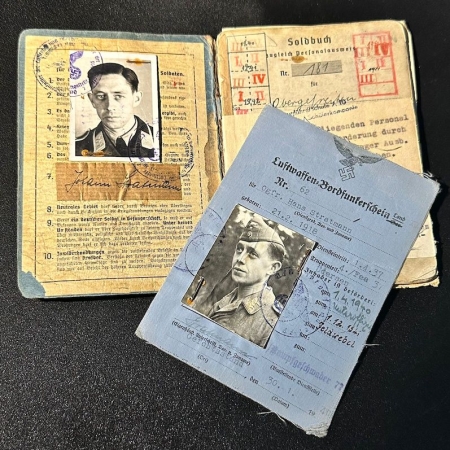
WWII German Luftwaffe Soldbuch – Oberfeldwebel Stratmann – Kampfgeschwarder 77 – Bordfunker – Injured at Eben Emael by Infantry Fire – The Blitz England – Battle of the Atlantic – 110 Missions – Gold Front Flying Clasp – EK1 (Sold)
In Soldbuch issued in 1939, to Stratmann, born in 1918 in Oberhausen, Germany. Stratmann would serve in the following units: 11.1939 – 2.1942 – II / Kampfgeschwarder 77 (6. Staffel) According to further research: Stratmann was injured in a Do 17 Z – whilst on a combat mission at Eben Emael Fortifications. On the 10.05.1940. In mid-July 1940 all three groups returned to Germany to convert to the Junkers Ju 88. When III./KG 77 returned to France in late August (it was still based at Regensburg on 26 August) it had 35 Ju 88s operational. These groups suffered losses of 9 Ju 88s on a single mission against Gravesend on 18 September, one of the highest losses of any gruppe in a single mission.[1] I./KG 77 in conjunction with II. and III. gruppe supported operations during the Blitz. On 27 September I./KG 77 lost six J 88s when raiding London, while II./KG 77 lost another six on the same night.During 1941 the Geschwader also took part in the Battle of the Atlantic. It attempted to support the German battleship Bismarck during her Atlantic operation during 26–28 May 1941. However, the unit was unable to intervene before she sank. The Geschwader sank the Royal Navy destroyer HMS Mashona on 28 May 1941, as the British forces withdrew to port. 2.1942 – 5.1943 – Transport vII Flieger Korps 06.1943 – Frontflieger Sammelgruppe – Lippstadt/Westfahlen. 10.1943 – Erprobungstelle der Luftwaffe Udetfeld – Technische Kompanie An interesting group testing Luftwaffe equipment. 10.1944 – Frontflieger Sammelgruppe Quedlinburg 2.3.1945 – Flugzeugführerschule A10 – Warnemünde / Schülerkompanie Medals / Qualifications 1. Radio Operator & Air Gunner’s Badge 2. Iron Cross Second Class – 13.5.1940 – Eben Emael 3. Wounds Badge in Black – 13.5.1940 – Eben Emael 4. Iron Cross First Class – 3.6.1941 – Battle of the Atlantic 5. Front Flying Clasp in Gold – 15.1.1942 – 110 Front Missions Completed 6. Qualifications – His Bordfunkerschein for radio operator was obtained in January 1940 with Kampfgeschwarder 77 in the field. Signature Major Krebs. Comments: It seems he was victim of his own trade, he was granted leave in November 1944, his home was hit by an allied bombing raid. What is really nice about this Soldbuch is the extras inside it, In the front of the Soldbuch is a very nice entry.
-

WWII German Lohnbuch – Junkers Manufacture in Italy – Aircraft Assembly – German Kurt Richter – Caproni Aeronautica Bergamasca –
Richter worked for the RLM (Luftwaffe Command) in the aassembly of aircraft/repair of aircraft. He was employed at the Junkers Factories and according to his Lohnbuch (rare ID) he was working for the RLM in Odessa, Ukraine. And later Piacenza in Italy. The original ID issued at the air base in Italy displays a picture of Richter. Included is a the so called Paris Pass, for him to stay in Paris for a period. Issued by the Kommandant of Paris. It seems postwar he worked in the VEB in Eastern Germany (Dresden).
-

InterWar – Identity Paper with Original Photo – Ukrainian Cheka – 1927 – Counter Revolutionary – Secret Police – Ultra Rare
This incredible original ID was issued to a counter revolutionary named Mikhail Puchin – allowing him to serve in the buildings of Cheka. This is so rare it was already in a world class collection, issued in 1927. Comments: Incredibly Rare – could be further researched. Comes with a translation in English.
-
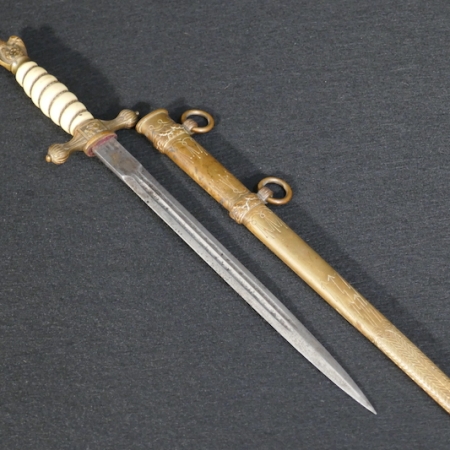
WWII German Navy – Officers Kriegsmarine Dagger – Uncleaned
An untouched KM Officers Dagger, this was a bring back to the USA after WW2. Seen some wear and small damage on the handle, the blade could be cleaned nicely. These are not so easy to get when they are not parts daggers. Probably worth to clean the blade, but we will leave this to a new owner. Price is shipped tracked worldwide.
-
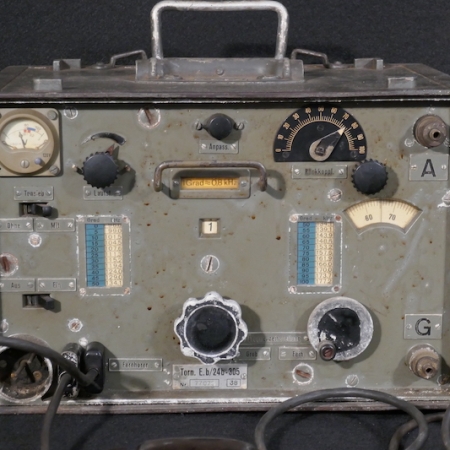
WWII German Wehrmacht Radio – Torn.E.b /24b-305 – With Morse Code Handset – Original Untouched – Rare
The Telefunken Torn.E.b /24b-305 (Spez 976 Bs) receiver was the end product of a series of Telefunken ‘portable’ receivers developed mainly for field use from the late 1920s onwards. They were intended for use both as a general purpose field receiver and as an accompanying receiver for a number of transmitters of the type normally found installed in signals trucks. The receiver frequency coverage is from 100kHz to 6670kHz. The earliest version was designed by Telefunken in the late 1920s as Spez 276 Bs and this was revamped in the early 1930s as Tornister Empfanger (portable receiver) Spez 445 Bs. By later standards it could be described as clumsy. Not unlike the National HRO, it employed plug-in coil units (three of them marked Kurz, Mittel and Lang) to cover the frequency range (see cover photo). The circuit employed four triode valves type RE 074 powered from a 90 volt battery and a 4.8 volt alkaline accumulator (type NC10). Radio, batteries and accessories were all in one case – quite a load for the signalman! With the development of the military general purpose two volt filament pentode valve (RV2 P800) the set was redesigned and split into two cases, one for the radio and one for the batteries and accessories. If necessary, the two cases could be clipped together. The plug-in coil system was dispensed with and replaced by an integral rotating coil turret. Trials with this equipment pointed to a need for some ergonomic improvements and some simplification of controls and other slight changes resulted in a more ‘user friendly’ front panel. The rectangular power supply plug and socket were replaced by a circular five pin connector which became standard for much field equipment. Thus, in 1936/37 the Telefunken Torn.E.b Spez 976 Bs was accepted for Wehrmacht use as the Torn.E.b/24b305 ( also known outside Germany as the AE95). Comments: This is an early model, with the original morse code handset, with Waffenamt stamps. Price includes shipping in the USA – if you are in Europe let us know via email which shipping method you would like due to weight.
-
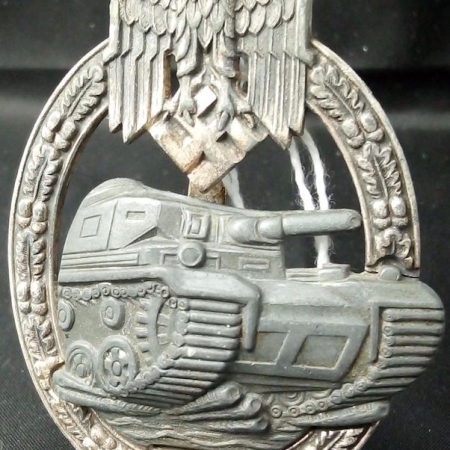
WWII German Panzer Assault Badge Silver – “25” – Original made by JFS Josef Felix, Gablonz – Rare
Panzer Assault Badge in Silver 25 assaults by Josef Felix, Gablonz Construction: Copper coated zinc constructed – with riveted zink tank and crimped in set up. Condition: a small crack but does not affect the display of the award. Price is posted inclusive tracked worldwide.
